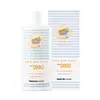What's inside
What's inside
 Key Ingredients
Key Ingredients

 Benefits
Benefits

 Concerns
Concerns

 Ingredients Side-by-side
Ingredients Side-by-side

Butyl Methoxydibenzoylmethane 3%
UV AbsorberHomosalate 10%
Skin ConditioningEthylhexyl Salicylate 5%
UV AbsorberOctocrylene 10%
UV AbsorberWater
Skin ConditioningStyrene/Acrylates Copolymer
Silica
AbrasiveDimethicone
EmollientPotassium Cetyl Phosphate
EmulsifyingBenzyl Alcohol
PerfumingBeeswax
Emulsion StabilisingCaprylyl Methicone
Skin ConditioningGlyceryl Stearate
EmollientPEG-100 Stearate
Cetyl Dimethicone
EmollientCaprylyl Glycol
EmollientEthylhexylglycerin
Skin ConditioningAluminum Starch Octenylsuccinate
AbsorbentBehenyl Alcohol
EmollientAcrylates/Dimethicone Copolymer
Skin ConditioningXanthan Gum
EmulsifyingSodium Polyacrylate
AbsorbentChlorphenesin
AntimicrobialDimethicone/PEG-10/15 Crosspolymer
Hydrolyzed Jojoba Esters
Skin ConditioningParfum
MaskingDisodium EDTA
Ethylhexyl Stearate
EmollientTocopheryl Acetate
AntioxidantBHT
AntioxidantTrideceth-6
EmulsifyingJojoba Esters
EmollientButyl Methoxydibenzoylmethane 3%, Homosalate 10%, Ethylhexyl Salicylate 5%, Octocrylene 10%, Water, Styrene/Acrylates Copolymer, Silica, Dimethicone, Potassium Cetyl Phosphate, Benzyl Alcohol, Beeswax, Caprylyl Methicone, Glyceryl Stearate, PEG-100 Stearate, Cetyl Dimethicone, Caprylyl Glycol, Ethylhexylglycerin, Aluminum Starch Octenylsuccinate, Behenyl Alcohol, Acrylates/Dimethicone Copolymer, Xanthan Gum, Sodium Polyacrylate, Chlorphenesin, Dimethicone/PEG-10/15 Crosspolymer, Hydrolyzed Jojoba Esters, Parfum, Disodium EDTA, Ethylhexyl Stearate, Tocopheryl Acetate, BHT, Trideceth-6, Jojoba Esters
Water
Skin ConditioningC12-15 Alkyl Benzoate
AntimicrobialTitanium Dioxide
Cosmetic ColorantButylene Glycol
HumectantDipropylene Glycol
HumectantNiacinamide
SmoothingButyloctyl Salicylate
Skin ConditioningCaprylyl Methicone
Skin Conditioning1,2-Hexanediol
Skin ConditioningAluminum Stearate
Cosmetic ColorantPolyhydroxystearic Acid
EmulsifyingCetyl Ethylhexanoate
EmollientSilica
AbrasivePentylene Glycol
Skin ConditioningPolymethylsilsesquioxane
Caprylic/Capric Triglyceride
MaskingAlumina
AbrasivePropanediol
SolventAmmonium Acryloyldimethyltaurate/Vp Copolymer
Parfum
MaskingPolyacrylate Crosspolymer-6
Emulsion StabilisingSaccharide Hydrolysate
HumectantSodium Stearoyl Glutamate
CleansingHydroxypropyl Methylcellulose Stearoxy Ether
Octyldodecanol
EmollientStearic Acid
CleansingEthylhexylglycerin
Skin ConditioningAdenosine
Skin ConditioningSalvia Hispanica Seed Extract
EmollientCentella Asiatica Extract
CleansingPortulaca Oleracea Extract
Skin ConditioningHouttuynia Cordata Extract
Skin ConditioningEchium Plantagineum Seed Oil
Skin ConditioningCurcuma Longa Root Extract
MaskingT-Butyl Alcohol
PerfumingCardiospermum Halicacabum Flower/Leaf/Vine Extract
Skin ConditioningHelianthus Annuus Seed Oil Unsaponifiables
EmollientGlycerin
HumectantTocopherol
AntioxidantCamellia Japonica Flower Extract
EmollientChamomilla Recutita Flower/Leaf Extract
AntimicrobialPancratium Maritimum Extract
BleachingWater, C12-15 Alkyl Benzoate, Titanium Dioxide, Butylene Glycol, Dipropylene Glycol, Niacinamide, Butyloctyl Salicylate, Caprylyl Methicone, 1,2-Hexanediol, Aluminum Stearate, Polyhydroxystearic Acid, Cetyl Ethylhexanoate, Silica, Pentylene Glycol, Polymethylsilsesquioxane, Caprylic/Capric Triglyceride, Alumina, Propanediol, Ammonium Acryloyldimethyltaurate/Vp Copolymer, Parfum, Polyacrylate Crosspolymer-6, Saccharide Hydrolysate, Sodium Stearoyl Glutamate, Hydroxypropyl Methylcellulose Stearoxy Ether, Octyldodecanol, Stearic Acid, Ethylhexylglycerin, Adenosine, Salvia Hispanica Seed Extract, Centella Asiatica Extract, Portulaca Oleracea Extract, Houttuynia Cordata Extract, Echium Plantagineum Seed Oil, Curcuma Longa Root Extract, T-Butyl Alcohol, Cardiospermum Halicacabum Flower/Leaf/Vine Extract, Helianthus Annuus Seed Oil Unsaponifiables, Glycerin, Tocopherol, Camellia Japonica Flower Extract, Chamomilla Recutita Flower/Leaf Extract, Pancratium Maritimum Extract
 Reviews
Reviews

Ingredients Explained
These ingredients are found in both products.
Ingredients higher up in an ingredient list are typically present in a larger amount.
Caprylyl Methicone is a type of silicone.
It helps soften and soothe the skin by creating a thin film on top. This film helps trap moisture, keeping your skin hydrated.
Ethylhexylglycerin (we can't pronounce this either) is commonly used as a preservative and skin softener. It is derived from glyceryl.
You might see Ethylhexylglycerin often paired with other preservatives such as phenoxyethanol. Ethylhexylglycerin has been found to increase the effectiveness of these other preservatives.
Parfum is a catch-all term for an ingredient or more that is used to give a scent to products.
Also called "fragrance", this ingredient can be a blend of hundreds of chemicals or plant oils. This means every product with "fragrance" or "parfum" in the ingredients list is a different mixture.
For instance, Habanolide is a proprietary trade name for a specific aroma chemical. When used as a fragrance ingredient in cosmetics, most aroma chemicals fall under the broad labeling category of “FRAGRANCE” or “PARFUM” according to EU and US regulations.
The term 'parfum' or 'fragrance' is not regulated in many countries. In many cases, it is up to the brand to define this term.
For instance, many brands choose to label themselves as "fragrance-free" because they are not using synthetic fragrances. However, their products may still contain ingredients such as essential oils that are considered a fragrance by INCI standards.
One example is Calendula flower extract. Calendula is an essential oil that still imparts a scent or 'fragrance'.
Depending on the blend, the ingredients in the mixture can cause allergies and sensitivities on the skin. Some ingredients that are known EU allergens include linalool and citronellol.
Parfum can also be used to mask or cover an unpleasant scent.
The bottom line is: not all fragrances/parfum/ingredients are created equally. If you are worried about fragrances, we recommend taking a closer look at an ingredient. And of course, we always recommend speaking with a professional.
Learn more about ParfumSilica, also known as silicon dioxide, is a naturally occurring mineral. It is used as a fine, spherical, and porous powder in cosmetics.
Though it has exfoliant properties, the function of silica varies depending on the product.
The unique structure of silica enhances the spreadability and adds smoothness, making it a great texture enhancer.
It is also used as an active carrier, emulsifier, and mattifier due to its ability to absorb excess oil.
In some products, tiny microneedles called spicules are made from silica or hydrolyzed sponge. When you rub them in, they lightly polish away dead skin layers and enhance the penetration of active ingredients.
Learn more about SilicaWater. It's the most common cosmetic ingredient of all. You'll usually see it at the top of ingredient lists, meaning that it makes up the largest part of the product.
So why is it so popular? Water most often acts as a solvent - this means that it helps dissolve other ingredients into the formulation.
You'll also recognize water as that liquid we all need to stay alive. If you see this, drink a glass of water. Stay hydrated!
Learn more about Water